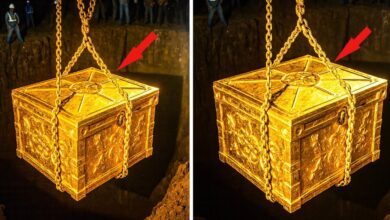Rick Lagina: “I just Found Out The Truth About The Oak Island Money Pit”
Rick Lagina: "I just Found Out The Truth About The Oak Island Money Pit"
That’s interesting. Yeah, the statement said it was close to 200 lb. I’m pretty sure it’s close to 200 lb, isn’t it, Jack?
In a stunning revelation that has left Oak Island enthusiasts on the edge of their seats, Rick Lagina drops a bombshell that changes everything we thought we knew about the mysterious Money Pit. Oak Island has been surrounded in mystery for years, with the elusive Money Pit at the heart of countless speculations and theories.
Today, we stand on the edge of revelation as Rick Lagina discloses findings that could redefine centuries-old narratives and rewrite history books. Stay tuned till the end to uncover the hidden secrets and untold stories behind the Oak Island Money Pit.
Rick Lagina’s revelation is a game-changer, and you will want to take advantage of the exclusive insights that could reshape the entire narrative of this centuries-old mystery.
In the heart of Oak Island’s mysteries lies the B4C shaft, a site of crucial significance in the relentless quest for the island’s hidden treasures. This breakthrough moment for Rick Lagina and his team marked a turning point in their exploration.
Situated a mere 50 ft north of the mysterious borehole, the B4C shaft emerged as a beacon of hope, hinting at the proximity to the legendary Money Pit. As the team excavated deeper, the anticipation grew. At a depth that had eluded many before, they came across signs that could potentially rewrite the island’s history.
The discovery of what appeared to be gold lying dormant for centuries sent ripples of excitement across the team. This glimmering find suggested they were on the right track, possibly closer than ever to the elusive treasure—an artifact that was absolutely connected to Oak Island and perhaps even here to this land.
The B4C shaft’s exploration was not just a physical journey into the depths of the Earth, but also a journey back in time. We have a couple of clues that what happened here appears to be so extensive, it could certainly have been people hiding treasure.
Previous discoveries in nearby clusters had already suggested the existence of wooden tunnels dating back to the 15th century, hinting at a complex and mysterious past. But the presence of gold and silver in the B4C shaft truly captivated the imagination, sparking intense speculation and rumors.
This discovery posed as many questions as it answered. How did such sophisticated engineering come to be on this remote island? Me, personally, I have to go back to the original story, and the original story is The Money Pit. What purpose did these tunnels serve? Were they mere decoys, or did they lead to a treasure chamber of historical significance?
The discovery of the 15th-century tunnels on Oak Island is a testament to the island’s deep and mysterious past. Unearthed by Rick Lagina and his team, these ancient passageways offer a glimpse into a time long gone, yet profoundly impactful on the island’s lore. Carved into the Earth centuries ago, these tunnels are remarkable for their age and the mysteries they hold within their silent, darkened paths.
The existence of such sophisticated structures from the 15th century raises a number of questions. The thing we found on Oak Island is that even the most subtle clue might have impact, right? Might have import, and that’s why we’re here—absolutely looking for clues. Who built these tunnels, and for what purpose?
The craftsmanship and effort required to construct such elaborate underground networks suggest a significant motive, possibly linked to the concealment or protection of something valuable. The discovery challenges our understanding of the region’s history, hinting at the presence of early European explorers or perhaps even earlier visitors to the island.
With their complex construction, these tunnels also point to a high level of engineering knowledge and skill. The builders understood the complex task of tunneling and the art of concealing their work, adding to the mystery of Oak Island.
The presence of these tunnels supports theories that Oak Island was a site of great importance, attracting attention from far and wide. For Rick and his team, this is one of your points, and there was a stone feature here—very obvious one. That’s wild.
The 15th-century tunnels are not just historical artifacts—they are echoes from the past, guiding them deeper into the mystery of Oak Island. Each tunnel could lead to the legendary Money Pit or a clue to understanding the island’s mysterious visitors. As they explore these ancient corridors, they tread a fine line between historical discovery and the enduring legend of Oak Island’s hidden treasures.
The presence of silver and gold was detected in the water from deep within the B4C shaft. The presence of such precious metals suggested they were on the verge of unraveling a secret fiercely guarded by time and legend.
Silver and gold in such quantities was more than just a significant find, though. All those are expected materials from Oak Island. They had a lot of iron, manganese, titanium, calcium, potassium, and aluminum—common elements that were all part of the geological landscape. Those were all what I would expect. It was a beacon, hinting at the possibility of the fabled Money Pit’s existence.
These precious metals raised critical questions about the treasure’s origins and extent. Will it lead them to a larger horde, perhaps linked to historical figures or lost civilizations? The discovery fueled speculation and theories ranging from pirate treasure measures to the lost wealth of the Templars. One of the ways the Knights Templar protected those pilgrims was by creating what we now know as the modern banking system.
For the team, this was not merely a discovery of wealth but of possibilities. Each piece of silver and gold unearthed was a clue—a piece of a puzzle that spans centuries. The find also represented a moment of validation for their efforts, a tangible reward for the years of toil and dedication in the unforgiving landscape of Oak Island.
As they delve deeper into the mystery, the silver and gold became a symbol of hope and perseverance. Actually, I have a copy of that picture right there—right there! Yeah, look at this. Right there, it’s perfect.
It was a reminder that beneath the layers of Earth and tales, the truth of Oak Island’s Money Pit awaited discovery. For Rick Lagina and his team, the journey was far from over. Still, the discovery of silver and gold marked a significant milestone, marking a new chapter in the island’s story. History maybe—it’s a different individual, and we can better pinpoint a time frame and where they came from.
Amidst the labyrinth of tunnels and the allure of gold and silver, Rick Lagina and his team unearthed artifacts that spoke volumes about Oak Island’s mysterious past, including an iron bolt and spike.
The reason for the dive was obviously to try to explain those two mystery targets up there. These seemingly mundane objects extracted from the island’s depths were historical treasures, offering a tangible connection to the people who once worked and possibly lived on this mysterious island.
The iron bolt, believed to date back to the 1800s or earlier, was not just a piece of metal, but a relic of the island’s past. Its discovery suggested the presence of human activity, possibly related to mining or construction. This artifact raised questions about the extent of historical operations on Oak Island. Was it part of a larger structure or machinery? Did it belong to the original creators of the Money Pit, or was it left by those who came later, drawn by the lure of hidden treasures?
Similarly, with its raw hand-forged appearance, they had looked at every one of those places, but not in a definitive sense. After they got the map, they went and looked at every one of those spots to see if there was something obvious. Now they had to look for the non-obvious. The iron spike whispered tales of labor and craftsmanship.
Its existence pointed to a time when every tool was made by hand, each bearing the unique signature of its creator. The spike’s age and style provided clues to the historical timeline of the island’s occupation, suggesting a period of intense human activity and possibly hinting at the methods used in constructing the island’s mysterious features.
In the relentless pursuit of Oak Island’s secrets, Rick Lagina and his team found a formidable adversary at 130 ft—a dense bedrock barrier. This natural obstacle in the B4C shaft represented a significant turning point in their quest, posing both a challenge and a mystery.
The encounter with bedrock at such a depth was not just a physical barrier, but a moment that tested the team’s resolve and ingenuity. The presence of bedrock in the path to the Money Pit was a sharp reminder of the island’s complex geological makeup. It suggested that the original creators of the Money Pit, if artificial, most likely possessed advanced knowledge of the island’s terrain.
The bedrock barrier raised questions about the methods and technologies used in the past, hinting at a level of sophistication that was unexpected for the time. For the team, this obstacle was a puzzle in itself. Was the bedrock intentionally used as a protective layer, concealing something of great value? Or was it a natural formation that the creators of the Money Pit had skillfully incorporated into their design?
It represented something—it’s not decorative, and I think there is a direct connection to Oak Island. The answers to these questions were crucial in understanding the true nature of the Money Pit and the intentions of those who built it. Navigating around or through this bedrock required a strategic team approach, demanding a combination of modern technology and historical knowledge, pushing the boundaries of their exploration techniques.
Despite the setback, the bedrock barrier at 130 ft deep in the mystery surrounding Oak Island served as a compelling reminder that the island still held many secrets tightly locked within its layers, challenging those who dared to uncover them.
The quest for the Oak Island treasure took a profound turn when Rick Lagina and his team uncovered layers of history through artificial structures and artifacts. These findings were not just remains of the past; they were keys to understanding the complex narrative of the island. Each structure and artifact revealed a new chapter in the island’s storied history, suggesting the presence of various groups over the centuries.
Among the most significant discoveries were the complex network of tunnels and shafts, masterfully engineered and strategically placed. These structures indicated a level of planning and expertise that was extraordinary for their time. The question of who built these tunnels and for what purpose fueled the team’s curiosity. Were they part of a sophisticated treasure-hiding system, or did they serve a different unknown purpose?
The artifacts found alongside these structures added depth to the mystery. The problem with doing this the simple way with a long-reach excavator is that we do not have a stable hole. I mean, if we had dug a big pit with stable sides, then we could go down and look at it.
Items ranging from personal belongings to tools spoke of the daily lives of those who once inhabited or visited the island. Whether a coin from a distant land or a simple domestic tool, each artifact provided a glimpse into the lives of people—people who were part of Oak Island’s history.
For Rick Lagina and his team, these artificial structures and artifacts were more than just historical finds. They were pieces of a puzzle that, when put together, would reveal the true story of Oak Island. Each layer of history uncovered brought them closer to understanding the island’s past and perhaps the legendary treasure itself.
At the heart of Oak Island’s mystery lies the 90-ft stone, a mysterious artifact that has captivated treasure hunters for generations. When Rick Lagina and his team delved into the depths of the island, reaching this critical depth, they encountered what could be one of the most significant pieces of the puzzle.
The stone, etched with cryptic symbols, suggested a labyrinth of secrets waiting to be unraveled. There appeared to be some very faint carvings in the face of the stone. It could be the original stone. It could be a huge breakthrough. It’s exciting! It’s just the beginning.
The discovery of the 90-ft stone was more than just an archaeological find. It was a window into the minds of those who engineered the Money Pit. The cryptic markings on the stone hinted at a sophisticated knowledge system, possibly used to encode valuable information. This raised fascinating questions about the creators of the Money Pit. Were they safeguarding something of immense value, or was the stone a red herring meant to mislead and confuse?
The stone’s placement at such a depth indicated a deliberate effort to mark a significant point within the pit. This strategic positioning led to theories of a complex underground network—perhaps a series of booby traps or hidden chambers designed to protect the pit’s secrets.
The idea of a maze beneath Oak Island, with the 90-ft stone as a key or a clue, added a thrilling dimension to the lore. For Rick Lagina and his team, the stone symbolized the challenges and mysteries of Oak Island. It represented a tangible piece of history, yet its true meaning and purpose remained elusive.
As they continued their exploration, the 90-ft stone stood as a testament to the enduring allure of Oak Island—a reminder that the island still held secrets deep within its labyrinth and depths, waiting to be discovered.





